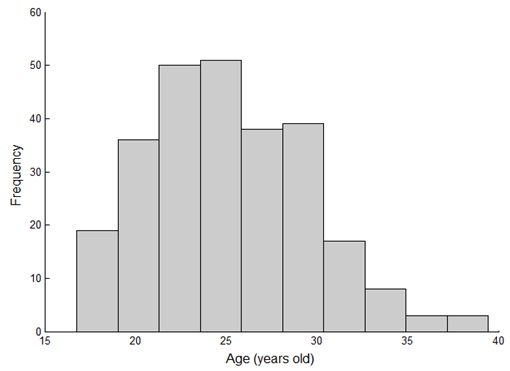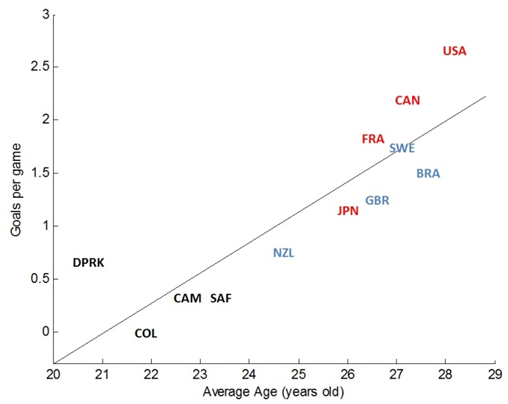-
Paper Information
- Previous Paper
- Paper Submission
-
Journal Information
- About This Journal
- Editorial Board
- Current Issue
- Archive
- Author Guidelines
- Contact Us
International Journal of Sports Science
p-ISSN: 2169-8759 e-ISSN: 2169-8791
2016; 6(3): 121-124
doi:10.5923/j.sports.20160603.09

Age of Peak Performance of Elite Women’s Soccer Players
1Faculty of Physical Education, State University of Campinas, Campinas, SP, Brazil
2Institute of Mathematics, Statistics and Compute Science, State University of Campinas, Campinas, SP, Brazil
Correspondence to: Júlia Barreira , Faculty of Physical Education, State University of Campinas, Campinas, SP, Brazil.
| Email: |  |
Copyright © 2016 Scientific & Academic Publishing. All Rights Reserved.
This work is licensed under the Creative Commons Attribution International License (CC BY).
http://creativecommons.org/licenses/by/4.0/

The aim of this study was to identify age of peak performance of elite women's soccer players and to analyze the relationship between average age and national team’s performance in London 2012 Olympic Games. Data from all the 256 female soccer players registered in the tournament were collected. From each player were collected the nationality and birth day which was used to calculate athlete’s age during the championship. All data were collected at FIFA official website. Athletes showed an average age of 25,4±4,4 years. Teams that were not qualified for the quarter-finals were younger, with an average age of 22,1±3,3 years. Teams with the best classifications in the championship had the highest average ages (>26 years). These results reinforce the need to prolong women’s soccer players’ career, thought a greater support for the athletes, allowing their physical, technical and tactical development throughout a long-term training program.
Keywords: Soccer, Performance, Athlete
Cite this paper: Júlia Barreira , Age of Peak Performance of Elite Women’s Soccer Players, International Journal of Sports Science, Vol. 6 No. 3, 2016, pp. 121-124. doi: 10.5923/j.sports.20160603.09.
Article Outline
1. Introduction
- The women’s soccer became an Olympic sport in the 1996 Summer Olympic Games, hosted by Atlanta, USA. Since then, the number of participant teams has increased by 50%. Simultaneous to this greater visibility of the sport, the number of practitioners has improved significantly in the last two decades, becoming one of the most popular female sports [1, 2]. According to FIFA Women’s Football Survey [3], there are 30 million participants recorded in 2014, an increase of 38% from 2000, and 4,8 million female players registered in soccer associations.This greater participation resulted in an increasing attention of the scientific literature to women’s soccer [4]. Most of the studies have investigated the sociological and physiological aspects of the sport and the frequent injuries suffered by the athletes. Just a few studies have focus on the relationship between age and elite women’s soccer players’ performance.Delorme, Boiché and Raspaud [5] and Vincent and Glamser [6] studied the relative age effect in athlete’s performance. Haugen et al. [1], Haugen et al. [2], Mujika et al. [7], Manson, Brughelli and Harris [8] analyzed the physiological characteristics of elite female soccer players across all FIFA age brackets. However, no study until the moment has investigated the age of peak performance of the athletes and it’s relation to team’s performance.The knowledge of age of peak performance can provide valuable information to coaches and professional involved in training to plan long-term training programs and to help promote athlete’s progression towards their performance targets [9]. Such information is also useful in the decisions of athlete-selection for major competition and in allocating funding and resources based on an athlete’s chances of success [9-11].In scientific research three methods are usually used to identify the age of peak performance in elite sports: using the age at which top athletes achieved their best performance; calculating the age of top athletes competing at events such as the Olympics and World Championship; or analyzing the age-related career performance of top athletes [9]. Based on the elite female soccer players which participated in London 2012 Olympic Games, the aim of this study was to identify the peak of age performance of women's soccer players and the relationship between average age and team’s performance.
2. Methods
2.1. Sample and Procedures
- All data were collected at the official website of the Fédération Internationale de Football Association (FIFA). Data used in this study are public and available online.There were 12 women’s soccer teams participating in London 2012 Olympic Game: Brazil (BRA), Cameroon (CAM), Colombia (COL), France (FRA), Great Britain (GBR), Japan (JPN), Korea DPR (DPRK), New Zeland (NZL), South Africa (SAF), Sweden (SWE) and United States (USA). Data from all the athletes who were registered in the tournament, 256 female soccer players of all participating national teams, were collected. Database included all the line players, goalkeepers and reserve players. There were no exclusion criteria. Of each player were collected the position, nationality and birth day. Using the birth day and the period of the competition, the age of each athlete was calculated at the moment of the Games. To analyze the relationship between the age of the athletes and the national teams’ performance it was also collected the amount of goals scored by each team and the number of matches played by them. Goals performed in penalty decisions were not considered in this study. Apart from the final classification, the ratio of goals per game was also used as a performance indicator.
2.2. Statistical Analysis
- All data were tabulated and arranged in Microsoft Excel worksheet and then exported to MATLAB® 2007 (The MathWorks Inc., Massachusetts, USA) program in which were performed all statistical analyses. Descriptive statistics (mean, standard deviation, minimum, maximum) were used to summarize the collected data. The data normality was tested by Lilliefors test. The average age of the different teams was compared by the analysis of variance (ANOVA) with the Tukey post-hoc test. The relation between goals per game and average age of the teams was analyzed thought the scatter plot and Pearson’s correlation coefficient. The significance level of 0.05 was adopted.
3. Results
- In women’s soccer tournament in London 2012 Olympic Games there were 71 goals scored and 26 matches played. The number of goals scored per team, number of matches played and ratio of goals per match are shown in Table 1.
|
 | Figure 1. Female soccer player’s age in London 2012 Olympic Games |
|
4. Discussion
- The aim of this study was to analyze the age of peak performance of elite women’s soccer player and the relationship between age average and team’s performance. We found an average age of 25 years, varying from 16 to 39. National teams that were not qualified for the quarter-finals showed the lowest average ages. Teams with the best classifications in the championship have the highest average ages (>26 years) and great ratios of goals per games. This was the first study to investigate the age of peak performance of elite women’s soccer players. The average age found in this study is in accordance with Haugen et al. [1] and Haugen et al. [2] which showed that for Norwegian elite-series team coaches just the best players keep participating in soccer after 23 to 24 years of age.The analysis of the average age and the standard deviations showed that most of the athletes’ age is between 21 and 29 years. We found in this study a small amount of athletes over 30 years. It is known that the game consists of stimuli of high-intensity aerobic and speed endurance fitness [12, 13], requiring a high fitness of the resistance strength, agility and speed capacities of the athletes [7, 8]. The intermittent feature of the sport, coupled with the high physical demand, limit the peak performance age of the athletes. The results of this study confirmed that sports which require a high fitness of strength and power capacities limit the age of the best performances until the 30 years [14].These results are important for the planning career of the athletes which may achieve their best performance between 20 and 30 years and which may be aware of the possibilities of retirement after the 30 years. We found that the countries with the lowest average ages, of approximately 22,2 years, did not qualify for the quarter-finals. National teams with older players had greater classifications and higher ratio of goals per game than those with younger athletes. Possibly, this performance reflects the best physical fitness of older athletes. Mujika et al. [7] showed that senior level female soccer players (20–26 years) fitness in countermovement jump and agility tests was better than junior players (16–19 years). Manson, Brughelli and Harris [8] analyzed the physiological characteristics of 51 elite female soccer players across all FIFA age brackets (U17, U20 and Senior). They found that U17 group had lower isokinetic strength compare to the others groups and senior athletes had the higher scores in VO2 max and in leg power compared with both U17 and U20 group. In addition to the physiological aspects, the success of older teams can be explained by a greater technical, tactical and psychological development. And when it comes to a national team, probably the athletes have also a better integration among them. These results reinforce the need to prolong women’s soccer players’ career, thought a greater support for the athletes, allowing their physical, technical and tactical development throughout a long-term training program. Analyzing the national teams’ performance through the ratio of goals per games we found that the teams qualified to the quarter-finals showed a ratio of at least one goal per game. These results allow pointing out, through the teams’ performance analysis at the beginning of the championship, the potential teams for the Olympic quarter-finals.It’s important to recognize the limitations of the data collection of this study. It was collected all information available at the official FIFA website about the women’s soccer players participating of the London 2012 Olympic Game. More information about the athletes would allowed an even better knowledge and discussion about the characteristics of women’s soccer athletes and its relation to the their performances. The results of this study provides new knowledge about the sport and suggest the need of new studies investigating how to prolong the athlete career in women’s soccer teams and which are the main factors developed during the training which allow the older national teams to have greater performances.
5. Conclusions
- From the results presented in this study we found that elite women’s soccer players present an average age of 25 years. The analysis of the performance of national teams in London 2012 Olympic Games showed that teams with older players have greater success than those with younger athletes.
 Abstract
Abstract Reference
Reference Full-Text PDF
Full-Text PDF Full-text HTML
Full-text HTML

